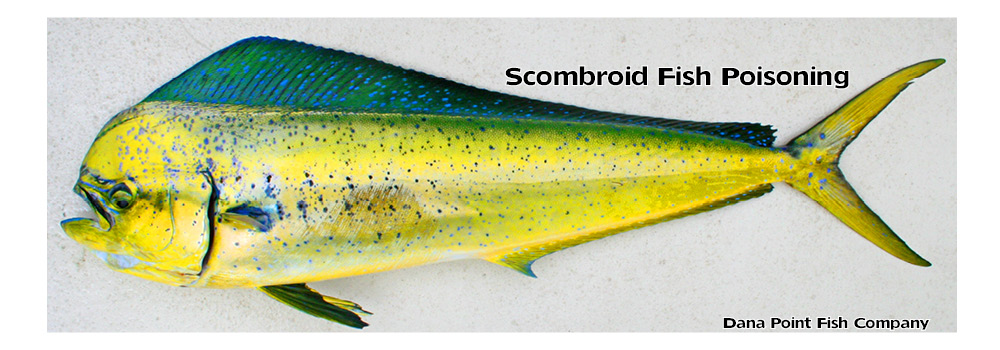Scombridae is the family name of the fish associated with Scombroid fish poisoning. While the name comes from the family name of fish closely associated with scombroid poisoning, non-scombroid fish can be affected. Fish that are susceptible to scombroid poisoning include: tuna, mahi mahi (dolphinfish or dorado), amberjack, mackerel, skipjack, wahoo, yellowfin tuna, and others.
Fish may or may not have an indicating odor. Affected fish, if consumed, may have a metallic taste due to histamine presence. This seafood poisoning is not from an actual bacteria or virus, but by the elevated levels of histamines caused by meat degradation (improper storage after it is caught). The histamine is not destroyed by cooking the fish. Delayed refrigeration, or refrigeration that is not adequate enough, results in natural bacteria found in these warm water fish to grow in abundance.
Symptoms of scombroid seafood poisoning surfaces within few minutes to 1 hour after eating infected fish. Symptoms last 8 to 12 hours, with fatalities extremely rare. If seeking medical care, a sample of the fish is needed for testing the fish for scombroid poisoning. Actual symptoms include:
- Throbbing, or intense headache
- Nausea and vomiting
- Hives and/or a burning in the mouth
- Palpitations
- Severe cramps
- Sunburn-like flushing involving face, sometimes neck, upper torso and arms
Avoid scombroid poisoning by ensuring fish is purchased from a reputable fish monger, and if the fish is caught fresh, that it is properly cooled after catching.
Resources:
“Food Safety Facts on Scombroid Poisoning.” Government of Canada, Canadian Food Inspection Agency, Affaires Publiques. Canadian Food Inspection Agency, 20 Mar. 2012. Web. 19 Feb. 2014.
“Scombroid Fish Poisoning.” Scombroid Fish Poisoning. California Department of Public Health, 12 May 2008. Web. 19 Feb. 2014.
“Scombrotoxin Poisoning and Decomposition.” Foodborne Illness & Contaminants: Buy, Store & Serve Safe Food. U.S. Department of Health and Human Services, 22 Mar. 2013. Web. 19 Feb. 2014.

